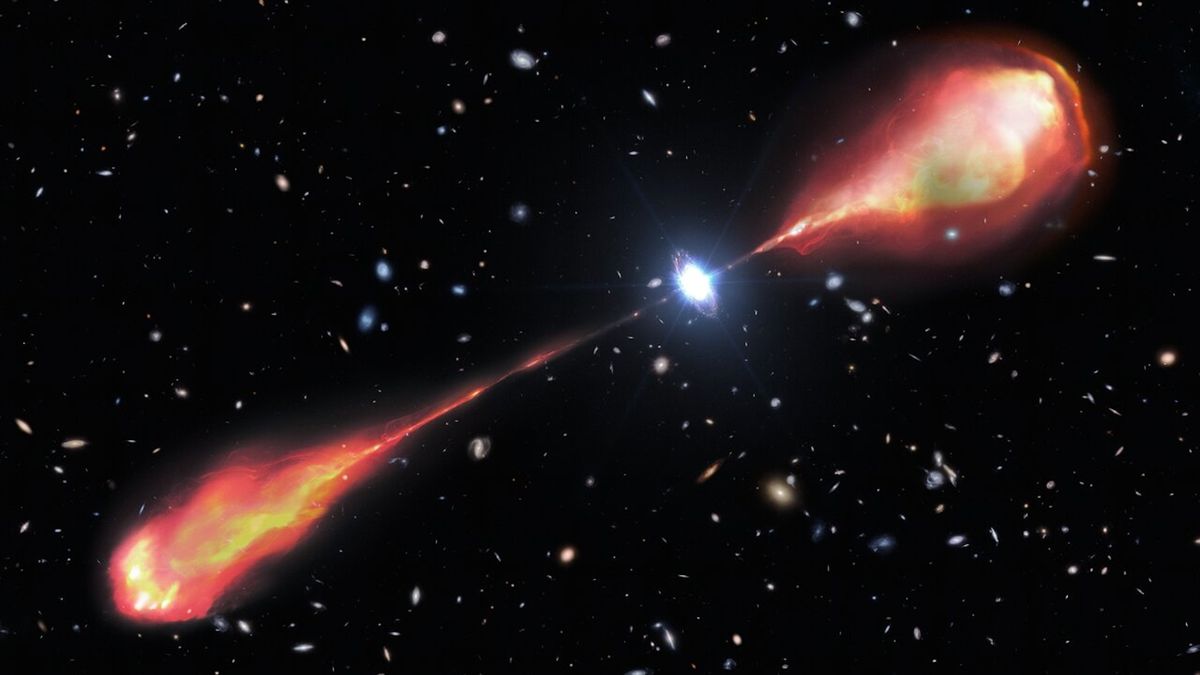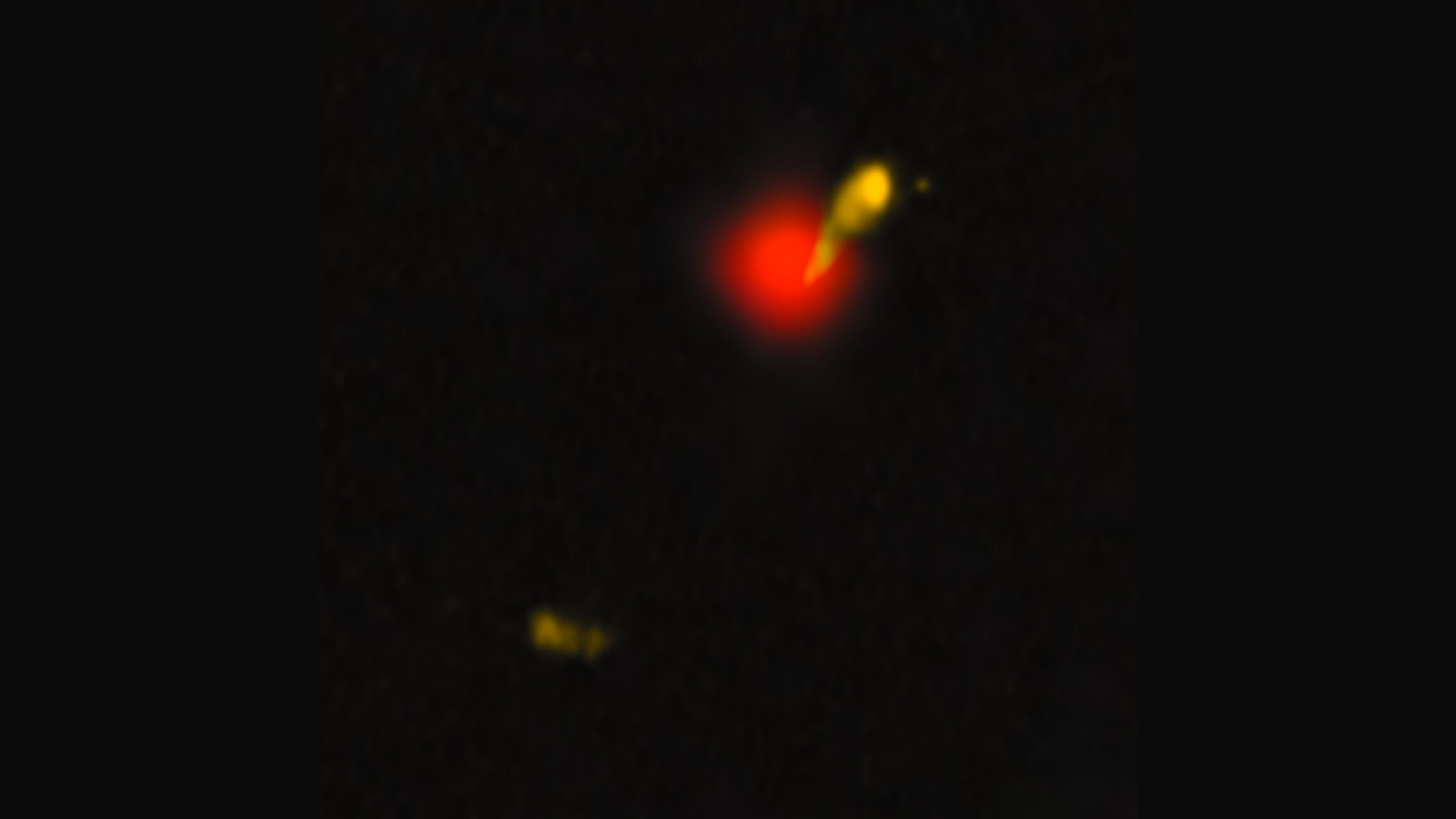
Astronomers have made an exciting discovery of a black hole jet that erupted when the universe was just under 1.2 billion years old, accounting for about 9% of its current age. This impressive jet stretches across 200,000 light-years, making it twice as wide as the Milky Way, positioning it as the largest black hole jet ever detected from such an early time in cosmic history.
For decades, astronomers have observed that black holes at the centers of galaxies consume surrounding gas and dust, forming a swirling disk. As this material spirals inward, it generates vast amounts of energy through friction, causing black holes to eject some material as powerful jets. While radio telescopes have identified hundreds of such jets — including very large jets — this is the first of its kind documented in the far reaches of the early universe.
“This groundbreaking discovery demonstrates that these jets do exist and are detectable,” stated Anniek Gloudemans, a postdoctoral research fellow at the National Science Foundation’s NOIRLab, who led the study. Along with clarifying the timeline for the formation of the first black hole jets, this finding aids astronomers in understanding how these jets may have influenced the early development of their host galaxies.
‘We Were Astonished, Yet Cautious’
The newly identified jet emits from both sides of a feeding black hole — a quasar dubbed J1601+3102, which has a mass 450 million times that of the Sun and resides approximately 10 billion to 13 billion light-years away from Earth.
The quasar was first identified in 2022 by a cluster of radio antennas in the Netherlands, part of the Low Frequency Array (LOFAR). This initial discovery, also led by Gloudemans, revealed that this quasar outshines its host galaxy immensely, appearing as the brightest within a survey of nearly two dozen similar objects conducted by LOFAR.
Related: Black Holes Might Be Fueling the Expansion of the Universe, According to New Research
This extraordinary brightness attracted Gloudemans’ attention, prompting her team to conduct detailed follow-up observations. Utilizing all 51 LOFAR antennas across Europe allowed researchers to create a continent-sized radio telescope that amplified the detail of their observations by 20 times compared to previous efforts. The resulting imagery of the black hole jet was essential in validating its magnitude, as detailed in a study published on February 6 in The Astrophysical Journal Letters.
Crucially, the images revealed a northern lobe of the jet extending 29,358 light-years from the quasar and a southern bulge measuring an astonishing 186,954 light-years. Further investigation confirmed the southern feature as a counterjet, interpreting it as the largest jet detected from the early universe.
“We were astonished but also cautious; we ensured we gathered comprehensive evidence before releasing our findings,” Gloudemans remarked.

An Unprecedented Luminescence
While large jets are not rare in nearby galaxies, their detection has been elusive in the early universe. This is primarily due to the radiation remnants from the Big Bang — known as the cosmic microwave background — being much more intense during earlier epochs when the universe was smaller and denser. This background radiation interacts with black hole jets, causing them to weaken and making them hard to spot with telescopes—like the newly detected jet.
“The extreme characteristics of this object are why we can observe it from Earth, despite its great distance,” Gloudemans explained in a statement. Interestingly, data from the Gemini Observatory in Hawaii indicate that the black hole associated with this jet is relatively small compared to other quasars from the early universe, which typically possess masses reaching billions of solar masses.
This observation implies that powerful jets can be generated by black holes that are not exceptionally massive or heavily accreting near their theoretical limits, according to Gloudemans’ insights.
“We anticipated that this newly discovered jet would be sourced from an extraordinary black hole; however, this was not the case,” she noted. To gain a more comprehensive understanding of the prevalence of these extended jets in the early universe, more discoveries are needed, though this work indicates that a black hole does not need to be extremely massive to produce such a jet in this era.
The significant energy output from black hole jets has the potential to influence galactic evolution via multiple mechanisms that regulate star formation material. Consequently, J1601+3102 will serve as an invaluable cosmic laboratory for exploring how jets affect galaxy formation in the early universe.
Looking ahead, Gloudemans believes future observations will uncover more extended radio jets from similar epochs in the universe, asserting, “There are certainly more of these expansive radio jets waiting to be discovered.”









